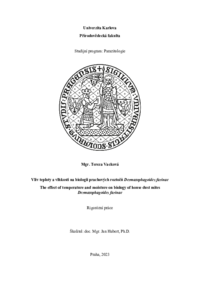Vliv teploty a vlhkosti na biologii prachových roztočů Dermatophagoides farinae
The effect of temperature and moisture on biology of house dust mites Dermatophagoides farinae
rigorózní práce (OBHÁJENO)

Omezená dostupnost dokumentu
Celý dokument nebo jeho části jsou nepřístupné do 18. 09. 2026
Důvod omezené dostupnosti:
ochrana informací chráněných zvláštním zákonem
Zobrazit/
Trvalý odkaz
http://hdl.handle.net/20.500.11956/185800Identifikátory
SIS: 260760
Kolekce
- Kvalifikační práce [21483]
Autor
Vedoucí práce
Oponent práce
Votýpka, Jan
Fakulta / součást
Přírodovědecká fakulta
Obor
Parazitologie
Katedra / ústav / klinika
Katedra parazitologie
Datum obhajoby
18. 9. 2023
Nakladatel
Univerzita Karlova, Přírodovědecká fakultaJazyk
Čeština
Známka
Prospěl/a
Biologie a schopnost alergenní produkce prachových roztočů jsou významně ovlivněny hygrotermálními faktory (teplotou a vlhkostí). Tato práce shrnuje studie zabývající se vlivem teploty a vlhkosti na populační růst roztočů druhu Dermatophagoides farinae, jejich metabolismus (reprezentovaný mírou respirace) a chování v rámci teplotního gradientu (simulujícího podmínky ve vertikálním průřezu matrace). Během experimentálního měření populační dynamiky kolonií D. farinae chovaných při různých kombinacích teplot a vlhkostí (v rozpětí 15-35 řC a 62-94% RH) byl pozorován průměrně nejvyšší a zároveň stabilní populační růst při 28 řC a 85% RH. Ze studovaného rozpětí teplot (15-35 řC) vykazovali roztoči tohoto druhu nejvyšší produkci CO2 při 30 řC. Za těchto podmínek u nich byla patrná celkem dvě respirační maxima - při kombinaci s 90% RH a 65% RH. V teplotním gradientu (19 až 41 řC) se potravu přijímající roztoči nejčastěji zdržovali v sektoru s rozpětím 32-36 řC. Tento jev byl patrný v případě experimentu s čtyřiadvacetihodinovým teplotním gradientem, ale zároveň též i při pětidenním experimentu zahrnujícím periodické střídání zapnutého gradientu (8 h/denně) a chladnutí aparatury na pokojovou teplotu (16 h/denně). Naopak nejvíce potravu nepřijímajících roztočů bylo v obou variantách experimentů nalezeno v...
The biology and allergen production of dust mites are significantly influenced by hygrothermal factors (temperature and humidity). This thesis summarizes studies dealing with the effect of temperature and humidity on the population growth of mites species Dermatophagoides farinae, their metabolism (represented by their respiration rate) and migration patterns within a temperature gradient (simulating conditions in the vertical section of a mattress). D. farinae colonies reared at different combinations of temperature and humidity (in the range of 15-35 řC and 62-94% RH) showed the average highest and stable population growth at 28 řC and 85% RH. The highest CO2 production of this species was - within studied temperature (15-35 řC) - observed at 30 řC. At this temperature there were two respiration peaks at RH 90% (smaller peak) and 65% (larger peak). Within a temperature gradient (19-41 řC), fed mites were most often found in the sector with a temperature range of 32-36 řC. This phenomenon was observed in both experimental designes: in a stable (24 h) temperature gradient, but also in experiment with 5 days of alternating cycles of the same gradient (8 h / day) and room temperature (16 h / day). Conversely, the highest number of non-feeding mites was found in the sector with a temperature range of...
